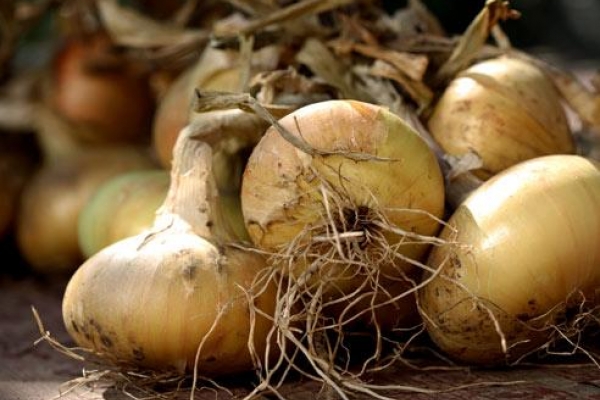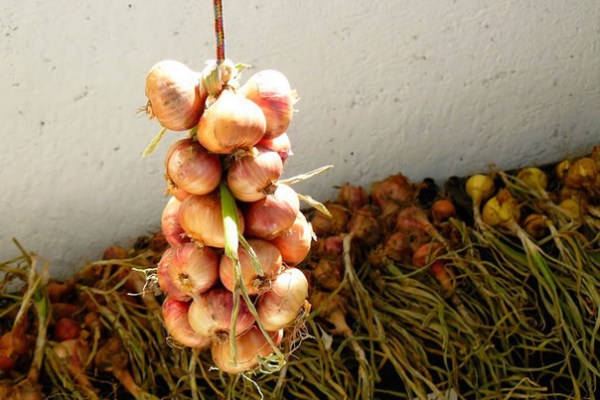When to remove onions from the garden and how to do it right
Cleaning time
We are used to using leeks in many dishes. It is important to know not only how to correctly plant and grow this very useful vegetable, but also when to harvest onions. It is necessary to collect exactly the ripe root crop, but at the same time to prevent it from overripe. If you remove leeks from the garden too early, pathogens of various diseases can get into it. And when the vegetable is overripe, you can forget about its normal long-term storage. It is recommended to harvest onions from the beds at the end of July - August. Much here depends on the climatic conditions in which the site is located. But since the time frame for this process is quite large, most gardeners want to know how to more accurately determine the moment of ripening of leeks. There are several reliable ways. One of them is considered a mathematical method, based on knowledge of the average ripening period of a given vegetable.
There are several reliable ways. One of them is considered a mathematical method, based on knowledge of the average ripening period of a given vegetable.
If you add 68 - 83 days to the planting day of the onion, you can roughly get the harvest date.
It is also necessary to take into account the climate, peculiarities of the root crop variety, weather conditions and other factors. Therefore, it is considered more reliable to determine the ripening of the leek and the day of its collection from the garden, focusing on the appearance.
The first signs of ripening of a vegetable will be yellowing leaves and dry stems. You can gently scoop up a few bulbs with a pitchfork to see if they are ripe. When examining the onion, pay attention to its hardness, while the neck must be dry and soft to the touch, like the roots. Experienced gardeners, in an effort to help the leek ripen faster, mow the tops of the root crop about a week before the expected harvest date. Another way is to raise the leek to the ground using a fork or shovel. Winter onions ripen a little earlier, since it is customary to plant them in late autumn. But the recommendations for the timing of its cleaning are almost the same.
How to dig
It is recommended to dig onions in sunny and clear weather. If the weather is damp, the harvested onion will subsequently become spoiled, because it will rot intensively. Once upon a time, our grandmothers did not cut the feathers of the bulbs, but waited for them to dry well, and then braided them into braids. So it was more convenient to store the root crop, hanging it in any chosen place. How is it customary to dig up and store it today? You need to carefully dig up each onion, and then remove it from the ground with your hands.
In no case should you pull the vegetable by the tops. When removing the bow from the ground, you should not knock it on a hard surface, as it is quite sensitive to damage. It will be best to wipe the onion after digging it up. After you pull it out of the garden in the morning, you need to leave the vegetable to dry in the sun. Until the evening, it is necessary to shake it up and periodically turn it over, then the root crop will dry out better. After that, the bow can be identified in the barn, in the attic or on the balcony. There he should stay for a couple of days to dry completely. A few hours after harvesting, the tops of the vegetables should be trimmed, leaving only about 10 cm, as well as the roots, without touching only a couple of centimeters.
What to do in the event that it rains suddenly, and the harvest can no longer be rescheduled? We'll have to dig the vegetable out of the wet soil. After that, it will need to be thoroughly washed, as well as cleaned of tops, roots and husks. It is also important to lay the crop in one row and let it dry well for about three weeks in a normally ventilated area. In this case, the culture in which young scales are formed during these days will be stored as well as the onion, which was harvested in clear weather.
How to dry properly
Those gardeners who are on the site every day during harvesting can dry onions right on the garden for about 7 to 12 days. To properly dry a vegetable, it must be laid out on a flat surface so that the bulbs lie in one direction and the feathers look in the other. Root crops are advised to be stacked in rows and in one layer. The sun can best decontaminate your crop, which must be turned over periodically.
Since there are still many warm days in August, it will not be difficult to dry the culture. Bulbs that start to deteriorate for a number of reasons need to be removed. Those that have already dried well can be woven into braids or folded into a stocking according to a long-proven method so that they can maintain their excellent appearance for as long as possible. It must be remembered that well-dried bulbs have a beautiful dark golden color, and their scales are normally detached and rustle in the hands, the tails must also be completely dry.
Onion Harvesting Video
A video on how to manually harvest onions, how to dry them and how to store them correctly.
